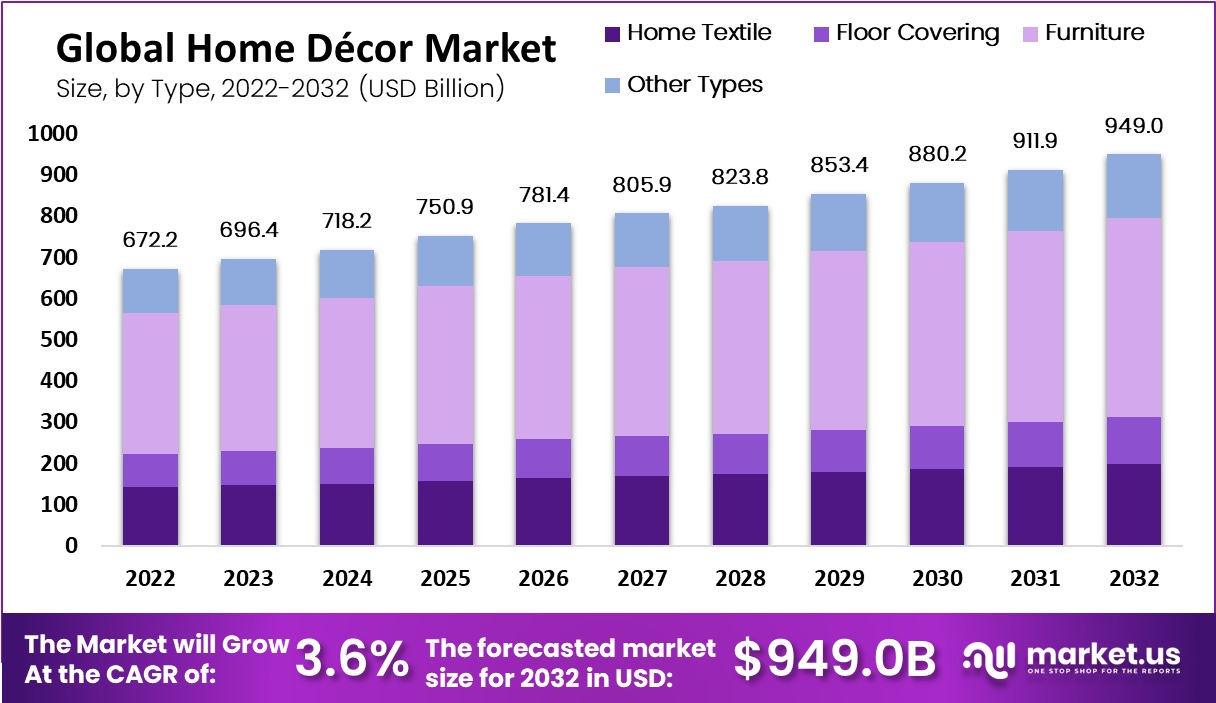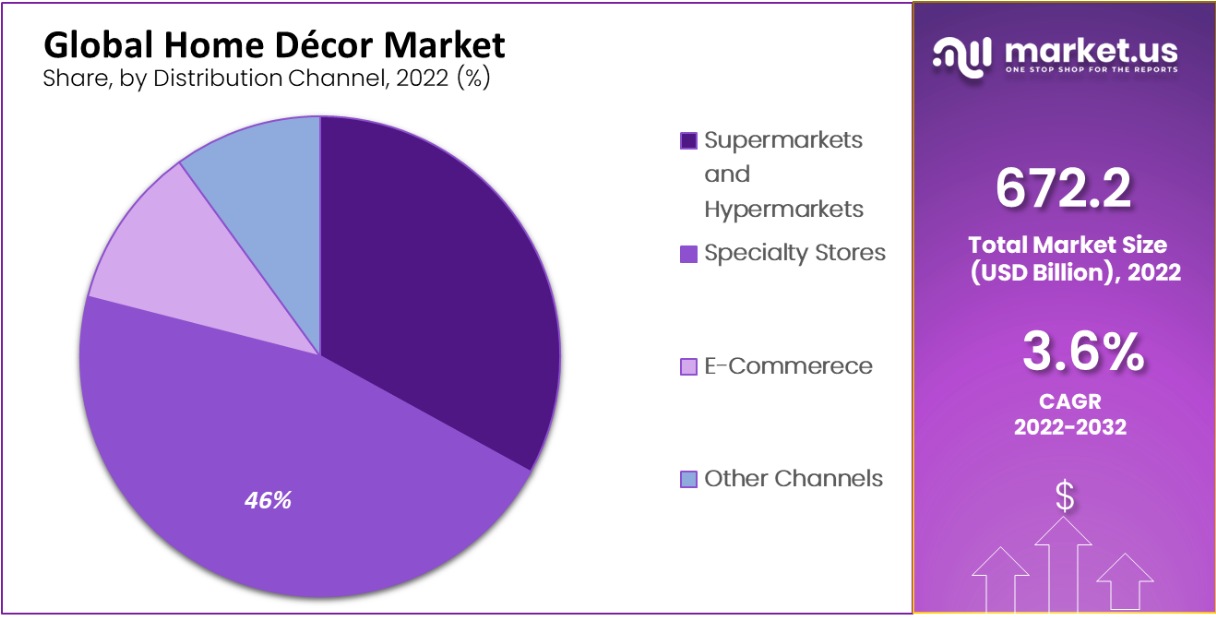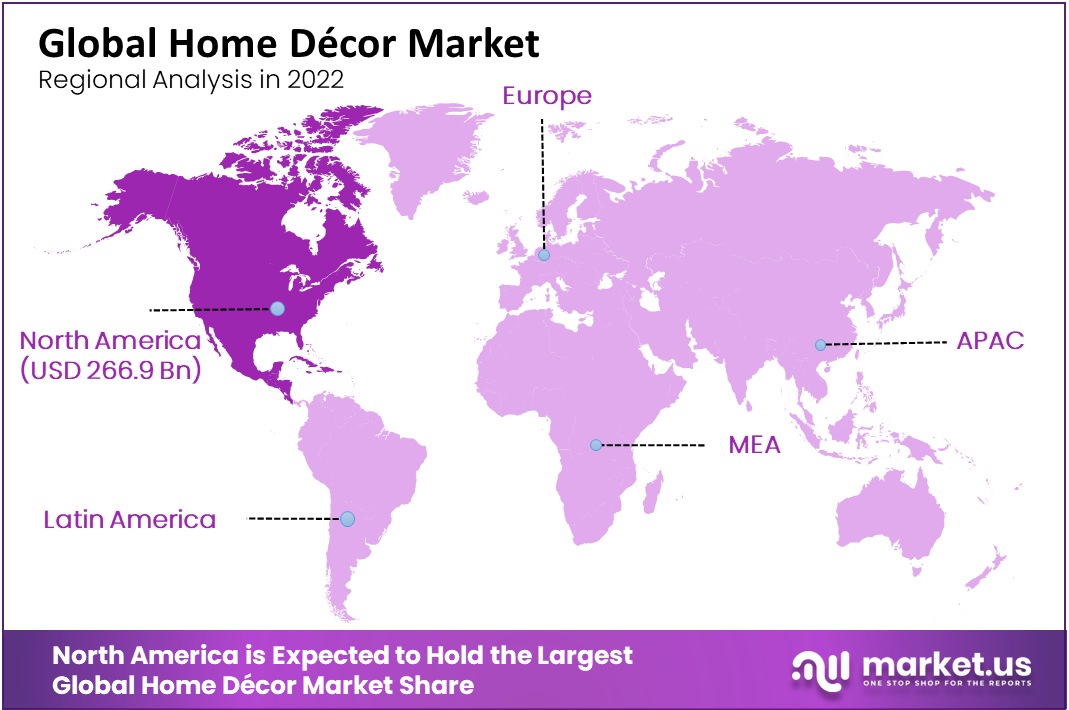Global Home Decor Market by Type (Home Textile, Floor Covering, and Other Types), by Distribution Channel (Hypermarket & Supermarket, and Other Channels), by Region, and Key Companies – Industry Segment Outlook, Market Assessment, Competition Scenario, Trends and Forecast 2023-2032
- Published date: Sep 2023
- Report ID: 32585
- Number of Pages: 368
- Format:
- keyboard_arrow_up
Quick Navigation
Report Overview
The Global Home Décor Market size is expected to be worth around USD 949 Billion by 2032 from USD 672.20 Billion in 2022, growing at a CAGR of 3.60% during the forecast period from 2023 to 2032.
Home decor is the art of designing the inside and outside of a house to look good and be useful for the people who live there. Products for decorating the home include a variety of items, such as furniture; textiles for the home, including those for the rug, the bathroom, the bed, the kitchen & dining areas, and the living room; and floor coverings like tiles, carpets, rugs, vinyl and rubber, wood & laminate, and others.
Both handwork and machine-based processes can be used to alter the designs of furniture. Products for home decor have been widely adopted in developed nations like the United States, Canada, and Germany, while consumer demand is expected to rise steadily in developing nations like China, Brazil, and India.

Driving Factors
Growing Awareness of Eco-Friendly Materials and Increasing the Number of Constructions to Propel the Home Decor Market
One of the main factors positively impacting the market is the increasing number of commercial and residential constructions, remodeling, and renovations. The increasing spending capacity and shifting population to urban areas are also driving the global demand for home decor products.
A positive outlook is also being created by a significant increase in trade activities for decorative products. This is in line with the increasing internet penetration and the shifting consumer dependence on smartphones, which are driving an increase in sales of home decor products via online platforms.
Manufacturers have lucrative growth opportunities due to the availability of aesthetic components at a discounted rate, as well as the ease of delivery to their homes and secure online payments.
Leading market players are encouraging the expansion of their product lines as a result of the growing public awareness of the advantages of employing eco-friendly materials. In addition, they are concentrating on strategic partnerships with interior designers in order to provide customers with individualized home decor items, which is anticipated to drive Home Decor market expansion in the upcoming years.
Restraining Factors
Rising Cost of Leather to Challenge the Market Expansion
The home decor industry relies heavily on raw material suppliers. High-quality wood is also hard to come by because natural materials like wood are tightly controlled when they are made and imported, which makes it harder for people to buy home decor products.
Leather is in high demand as a result of significant demand from industries like footwear and textiles. However, there is a limited supply of leather. The rising costs of raw materials brought on by these factors impede the expansion of the Home Decor market.
Growth Opportunities
Increasing Disposable Incoem and Improved Lifestyles Expected to Create Opportunites Over the Forecast Period
Globally, gross disposable income per person has increased. Consumers’ lifestyles are significantly improving, particularly in urban areas, as a result of an increase in disposable income. The demand for furniture, textiles, and floor coverings is on the rise as customers’ opulent lifestyles and increased construction activity make them essential components of modern living.
It is anticipated that consumers’ increased willingness to spend more on home decor items will provide lucrative opportunities for the global Home Decor market’s expansion as these products enhance homes’ aesthetic appeal.
Latest Trends
People are Opting More for High-Quality Furniture
Home Decor Market expansion has been fueled by the shifting preference of consumers for urban living as a result of the rising rate of urbanization. Changing one’s lifestyle necessitates the use of high-quality furniture and other furnishings.
Demand for home decor products will rise during the forecast period as a result of rising urbanization. In addition, it is anticipated that the expansion of the home decor market will be supplemented by growth in the real estate industry.
Type Analysis
The Floor Covering Segment Dominated the Market in 2022 Due to the Demand for Trendy Floor Coverings
The floor coverings sector, which makes up the majority of the Home Decor market, is anticipated to expand at a CAGR of 4.1% over the forecast period. Vinyl, rubber, tiles, wood & laminate, and other floor covering materials are available. The importance of recycling and reducing waste has significantly increased awareness.
Additionally, the flooring industry is affected by recycled materials like tiles, laminate, and wood. Customers have shown a lot of appreciation for trendy floor coverings that are also cheap and good for the environment.
The Asia-Pacific region has experienced rapid expansion as a result of ongoing development projects. Home Decor Market expansion is largely driven by rising urbanization and construction activity, particularly in China and India.
Due to the prevalence of Western culture and increased disposable income, customers are purchasing more furniture than ever before. Furniture is also needed more often as modular kitchens and lighting become more popular. Metal, wood, plastic, glass, leather, and other materials are used to make parts of furniture. They can be used alone or in combination with other materials.
Since they directly impact consumers’ decisions regarding whether or not to purchase a particular product, the design’s shape and structure play a significant role in the furniture industry. Additionally, urbanization and a rise in the concept of the nuclear family are contributing to the furniture industry’s expansion. The furniture industry is expected to benefit greatly from the expansion of the real estate industry and the rapid adoption of e-commerce platforms.
Distribution Channel Analysis
The Specialty Stores Segment Dominated the Market in 2022
The global Home Decor market is divided into supermarkets, hypermarkets, specialty stores, e-commerce, and other distribution channels. The market share of specialty stores is the largest and will grow at a 3.7% CAGR over the forecast period. The specialty outlet for home decor offers many products and similar items. This specialty shop provides specialized solutions for offices, apartments, corporate customers, and other locations.
Specialty shops offer superior customer service and expert advice to assist customers in choosing home decor items for different uses, such as outdoor furniture, kitchens, bedrooms, or outdoor spaces. Specialty shops sell home decor products at a higher level because consumers prefer to weigh and compare options before buying.
They also check the quality, dependability, color options, and accessories that are available at the shops. The future is expected to see a rise in specialty stores.
A supermarket is a self-service store that offers a wide range of products, including food, home goods, and accessories. Although it is smaller than a superstore or hypermarket, it is larger and offers more goods than typical stores. Because furniture products are stored in warehouses owned by different hypermarkets and supermarket players, logistics costs have been greatly reduced.
This has resulted in lower prices for home decor goods. Supermarkets and hypermarkets are focused on large home decor items such as floor coverings, textiles, and furniture used in offices, restaurants, and residential areas.
Hypermarkets and supermarkets have greatly improved their logistics chains in order to offer lower prices due to increasing competition from other features like e-commerce.

Key Market Segments:
Based on Type
- Home textile
- Floor covering
- Furniture
- Other Types
Based on the Distribution Channel
- Supermarkets and Hypermarkets
- Specialty Stores
- E-commerce
- Other Channels
COVID-19 Impact Analysis
The disruption in raw materials supply has caused many home decor companies around the globe to stop production. There were also restrictions on logistical mobility due to the coronavirus lockdown.
COVID-19 will see an increase in interior design demand as more people work remotely and require offices. Consumers have changed their buying habits since the pandemic. They now prefer to shop online for home decoration products than in physical stores.
Regional Analysis
Easy Accessibility on Both Online and Offline Platforms has Made North America the Dominant Region in the Market
In 2022, North America was the largest region and accounted for 39.7% of global revenue. Home Decor Market growth can be attributed to increased product accessibility and greater penetration of both online and offline interior design channels. This region is home to many market players and has seen a rise in the use of textiles, lighting, and decorative flooring.
Due to increasing consumer willingness to spend on home decor products, the United States is the dominant Home Decor market for outdoor furniture. Due to increasing urbanization, the Asia Pacific region will see significant market growth. This region has seen strong growth in the realty sector, which involves the construction of new buildings and houses.
The new decoration products on the Home Decor market are what drive the construction. Interior design products are in high demand due to the growth of interior design industries in emerging countries like India, China, and Indonesia. The trend towards modern design has also increased due to the increasing demand for green products. This has led to greater creativity in interior design.

Key Regions and Countries Covered in this Report:
- North America
- The US
- Canada
- Mexico
- Western Europe
- Germany
- France
- The UK
- Spain
- Italy
- Portugal
- Ireland
- Austria
- Switzerland
- Benelux
- Nordic
- Rest of Western Europe
- Eastern Europe
- Russia
- Poland
- The Czech Republic
- Greece
- Rest of Eastern Europe
- APAC
- China
- Japan
- South Korea
- India
- Australia & New Zealand
- Indonesia
- Malaysia
- Philippines
- Singapore
- Thailand
- Vietnam
- Rest of APAC
- Latin America
- Brazil
- Colombia
- Chile
- Argentina
- Costa Rica
- Rest of Latin America
- Middle East & Africa
- Algeria
- Egypt
- Israel
- Kuwait
- Nigeria
- Saudi Arabia
- South Africa
- Turkey
- United Arab Emirates
- Rest of MEA
Home Decor Market leaders are focusing on product innovation to increase their market share. Because consumers are increasingly looking for luxury and a high-end lifestyle, new product launches help to keep their interest alive.
Market Key Players:
Listed below are some of the most prominent home decor industry players.
- Inter IKEA Systems B.V.
- Kimball International Inc.
- Herman Miller, Inc.
- Home24
- Hanssem Corporation
- Koninklijke Philips N.V.
- Conair Corporation
- Suofeiya Home Collection Co., Ltd.
- Springs Window Fashions LLC
- Siemens AG
- Other Key Players
Recent Developments:
- Arttd’inox, a home and lifestyle brand owned by JSL Lifestyle, aims to generate Rs 100 million in three years. Arttd’inox is a business-to-consumer division of JSL Lifestyle, a Jindal Stainless (Hisar) Limited (JSHL) subsidiary. The company offers high-quality stainless steel products for kitchen and home decor.
- Dekulture Works, a lifestyle brand, has opened three stores in Bangalore. The company is in talks with a number of investors to raise approximately Rs 100 million for future expansion in Delhi, Mumbai, and other metropolitan areas.
- This fiscal, Kurlon intends to generate Rs 1,000 crore in revenue. Kurlon, a leading mattress manufacturer, intends to achieve Rs 1,000 crore in revenue and a 25% increase in sales this fiscal year.
Report Scope:
Report Features Description Market Value (2022) USD 672.2 Bn Forecast Revenue (2032) USD 949 Bn CAGR (2023-2032) 3.6% Base Year for Estimation 2022 Historic Period 2016-2022 Forecast Period 2023-2032 Report Coverage Revenue Forecast, Market Dynamics, COVID-19 Impact, Competitive Landscape, Recent Developments Segments Covered Based on Type- Home textile, Floor covering, Furniture, and Other Types; Based on Distribution Channel- Supermarkets and Hypermarkets, Specialty Stores, E-commerce, and Other Channels Regional Analysis North America – The US, Canada, & Mexico; Western Europe – Germany, France, The UK, Spain, Italy, Portugal, Ireland, Austria, Switzerland, Benelux, Nordic, & Rest of Western Europe; Eastern Europe – Russia, Poland, The Czech Republic, Greece, & Rest of Eastern Europe; APAC – China, Japan, South Korea, India, Australia & New Zealand, Indonesia, Malaysia, Philippines, Singapore, Thailand, Vietnam, & Rest of APAC; Latin America – Brazil, Colombia, Chile, Argentina, Costa Rica, & Rest of Latin America; the Middle East & Africa – Algeria, Egypt, Israel, Kuwait, Nigeria, Saudi Arabia, South Africa, Turkey, United Arab Emirates, & Rest of MEA Competitive Landscape Inter IKEA Systems B.V., Kimball International Inc., Herman Miller, Inc., home24, Hanssem Corporation, Koninklijke Philips N.V., Conair Corporation, Suofeiya Home Collection Co., Ltd., Springs Window Fashions LLC, Siemens AG, and Other Key Players Customization Scope Customization for segments, region/country-level will be provided. Moreover, additional customization can be done based on the requirements. Purchase Options We have three licenses to opt for Single User License, Multi-User License (Up to 5 Users), Corporate Use License (Unlimited User and Printable PDF) Frequently Asked Questions (FAQ)
What is the size of the Home Decor Market in 2022?The Home Decor Market size was estimated to be USD 672.2 billion in 2022.
What is the projected CAGR at which the Home Decor Market is expected to grow at?The Home Decor Market is expected to grow at a CAGR of 3.6% (2023-2032).
List the key industry players of the Home Decor Market?Inter IKEA Systems B.V., Kimball International Inc., Herman Miller, Inc., Home24, Hanssem Corporation, Koninklijke Philips N.V., Conair Corporation, Suofeiya Home Collection Co., Ltd., Springs Window Fashions LLC, Siemens AG, Other Key Players engaged in the Home Decor Market.
Which region is more appealing for vendors employed in the Home Decor Market?In 2022, North America was the largest region and accounted for 39.7% of global revenue. Market growth can be attributed to increased product accessibility and greater penetration of both online and offline interior design channels.

- Inter IKEA Systems B.V.
- Kimball International Inc.
- Herman Miller, Inc.
- Home24
- Hanssem Corporation
- Koninklijke Philips N.V.
- Conair Corporation
- Suofeiya Home Collection Co., Ltd.
- Springs Window Fashions LLC
- Siemens AG
- Other Key Players
- settingsSettings
Our Clients
| Single User $4,599 $3,499 USD / per unit save 24% | Multi User $5,999 $4,299 USD / per unit save 28% | Corporate User $7,299 $4,999 USD / per unit save 32% | |
|---|---|---|---|
| e-Access | |||
| Report Library Access | |||
| Data Set (Excel) | |||
| Company Profile Library Access | |||
| Interactive Dashboard | |||
| Free Custumization | No | up to 10 hrs work | up to 30 hrs work |
| Accessibility | 1 User | 2-5 User | Unlimited |
| Analyst Support | up to 20 hrs | up to 40 hrs | up to 50 hrs |
| Benefit | Up to 20% off on next purchase | Up to 25% off on next purchase | Up to 30% off on next purchase |
| Buy Now ($ 3,499) | Buy Now ($ 4,299) | Buy Now ($ 4,999) |












